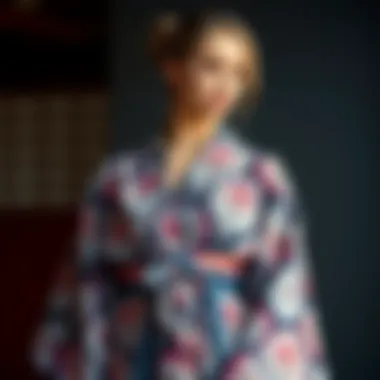Discovering the Geo Print Kimono in Fashion


Intro
The fashion landscape is an ever-changing tapestry woven from tradition, innovation, and personal expression. Among the myriad styles vying for attention, the geo print kimono has emerged as a striking fusion of past and present. This garment draws inspiration from traditional Japanese attire while incorporating modern design elements that make it fit for today’s diverse wardrobes. In the world of fashion, the kimono redefines versatility, transitioning seamlessly from casual outings to more refined occasions. Today, we’re diving into its history, cultural significance, and how to style this captivating piece so that it resonates with your personal identity.
Current Fashion Trends
As we navigate through the fast-paced world of fashion, the geo print kimono stands out not just as a trend but as a statement. The appeal lies in its adaptability and the boldness of its patterns. Designers are weaving a blend of geometric shapes that often tell a story, capturing the wanderlust of urban life while honoring the heritage from which it originates.
Seasonal Must-Haves
In spring and summertime, lightweight fabrics such as cotton and silk reign; they breathe well under the sun and keep you comfortable through light breezes. For a causal day out, consider pairing your geo print kimono with a simple white tank top and denim shorts. When the chill of autumn hits, heavier materials like wool or cashmere can bring warmth while maintaining style. You might layer a long-sleeve tee underneath and add some ankle boots for a chic look.
The geo print kimono captures a sort of elegance that is both refined and casual, merging effortlessly with both high and street fashion.
Iconic Styles to Embrace
Different designers bring their own spin to the kimono, ensuring variety on the racks. Here are some styles to consider:
- Drape Kimonos: Flowing and dramatic, perfect for making a statement.
- Asymmetrical Hem Kimonos: Adds a modern twist to traditional silhouettes, appealing to trendsetters.
- Belted Kimonos: Offers structure and versatility; ideal for transitioning from day to night.
Style Tips and Tricks
Mastering the art of styling a geo print kimono requires an eye for balance and a sense of personal style. It’s about complementing the kimono, not overshadowing it. Here’s how you can elevate your ensemble.
Mixing and Matching Outfits
Start by considering the colors in your kimono. If it showcases bold hues, opt for neutral undergarments and accessories. For instance, if your kimono is vivid, pair it lightly with a fitted black dress or simple jeans. When it comes to patterns, juxtaposition can be delightful; just make sure that the busyness of the patterns doesn’t clash. Think floral skirts with geo print kimonos, where one softens the edge of the other.
Care and Maintenance of Clothing
Keeping your geo print kimono in top shape is paramount. Hand washing is often recommended to preserve color and fabric integrity. If you must machine wash, use the gentle cycle and cold water, avoiding harsh detergents. Always hang to dry instead of tossing it into the dryer, as this can drastically change the fabric and fit. A touch of steam can work wonders for wrinkles, refreshing the garment while keeping it looking crisp.
In summary, the geo print kimono is more than just an article of clothing; it’s a canvas for self-expression blending history, culture, and modern aesthetics. By embracing this versatile piece, you can not only elevate your wardrobe but also pay homage to the rich cultural background from which it draws its roots.
Prelude to the Geo Print Kimono
The geo print kimono has surfaced as a real game-changer in modern fashion. It's not just the traditional kimono rehashed; rather, it's a fresh take on an age-old garment that brings together rich cultural heritage and contemporary aesthetics. The significance of this fusion lies in its ability to cater to a diverse audience, allowing people to express themselves through unique patterns that resonate on both personal and cultural levels.
At the heart of a geo print kimono is its striking geometric designs. Unlike conventional florals or traditional motifs, these patterns are often bold and abstract, drawing attention and sparking conversation. For fashion stylists and designers, the versatility of these prints allows for endless creativity. Not only can they work beautifully alone, but they can also complement various outfits, making them a staple in any wardrobe.
The benefits of adding a geo print kimono to one’s collection are manifold. First, it's an effortlessly chic addition that can elevate casual wear to something special. Pair it with jeans for a laid-back look or drape it over a sleek dress for formal occasions; the versatility is simply unmatched. Moreover, the lightweight fabrics often used in these garments spell comfort without skimping on style.
However, while the geo print kimono captures the essence of modernity, it's crucial to recognize the history behind its design. This article will delve deeper into the evolution of the kimono, exploring its origins and how it transformed through the ages. Such insights not only enhance our appreciation of this garment but also encourage a greater understanding of the cultural significance underpinning it.
Interestingly, as we venture into this exploration, we will highlight how the geo print kimono fits into the broader tapestry of fashion today. Understanding its appeal and the nuances of designs can greatly inform both retail strategies and customer preferences. After all, in a world increasingly focused on individual expression, the geo print kimono stands out as a canvas, merging tradition with modernity.
"Fashion is not just about clothes; it’s about telling a story, and the geo print kimono tells many."
By unriddling the multi-facets of the geo print kimono, this article serves as both a guide for fashion enthusiasts and a detailed examination for professionals in the industry. It’s more than a trending item; it’s a statement of cultural amalgamation that deserves a closer look.
Historical Context of Kimonos
The journey of the kimono is a fascinating one, interwoven with Japan’s rich cultural tapestry. Understanding the historical context of kimonos isn’t just about fabric and design; it touches on societal norms, artistic movements, and the everyday lives of people throughout the ages. This article seeks to explore how the geo print kimono, a modern twist on a traditional garment, has roots entrenched in the history of Japanese wear.
Origins of Kimono Wear
To appreciate the geo print kimono, one must first step back in time to its inception. The origins date back to the Heian period (794-1185), when the word "kimono" simply meant "thing to wear." The fabric was loose and allowed for ease of movement, suitable for the lifestyle of the period. At this time, garments were made from silk and adorned with elaborate patterns reflecting nature—birds, flowers, and seasonal changes, each telling a story.
In fact, kimonos were more than clothing; they were a reflection of the wearer’s status, gender, and age. For instance, younger women often wore brighter colors, while elderly women opted for more subdued hues. This nuanced expression of individuality can be likened to a living history book, where every fold and drape has significances tied back to traditions and daily life.
Evolution of Kimono Designs
Across centuries, the design and style of kimonos underwent significant transformations. The Edo period (1603-1868) marked a golden age for kimono fashion, with many artisans specializing in fabric dyeing techniques such as yuzen and shibori. The designs became increasingly elaborate and varied, with the introduction of geometric patterns, which contrasted the organic motifs of earlier generations.
As Japan opened up to the Western world in the Meiji era (1868-1912), kimonos adapted further, merging Western fashion elements with traditional styles. The incorporation of straight lines, leading to more tailored fits, reflected a shift in societal norms and cultural exchanges. This ongoing evolution set the stage for the modern interpretations seen today, where designers blend ancient traditions with contemporary aesthetics, most notably in the form of the geo print kimono.


Geometric Patterns in Traditional Kimonos
While organic motifs dominated early designs, geometric patterns carved out their unique niche in kimono history. These patterns often symbolize harmony and stability. Traditional geometric shapes like diamonds and hexagons carry deep meanings tied to hope and resilience.
In the modern context, the resurgence of these patterns is not merely about nostalgia but an embracing of innovation. Designers today explore bold contrasts and diverse color palettes, creating a striking juxtaposition with the traditional form.
"Patterns may change, but the essence of the kimono as a form of artistic expression remains intact."
Thus, the historical context of the geo print kimono provides invaluable insight into how kimonos have been adapted and appreciated through the ages. With each design telling its narrative, this not only preserves culture but also sustains the endless journey of fashion and identity.
For further reading about the cultural significance and history of the kimono, check resources like Wikipedia and Britannica, which delve deeply into the evolution and meaning behind this timeless garment.
The Appeal of Geo Print
The geo print kimono has managed to carve out a distinct niche in the fashion landscape, appealing to a diverse array of styles and tastes. Its bold geometric designs harmoniously blend tradition with contemporary touches. This importance cannot be overstated as it signifies a shift in fashion dynamics, where prints do not merely serve as adornments but also embody narratives and identities.
The beauty of the geo print lies in its adaptability. These pieces can transition effortlessly from casual daywear to sophisticated evening attire. The patterns often evoke a sense of modernity, allowing individuals to showcase their creativity without overshadowing the cultural heritage of the kimono itself. For fashion designers and stylists, this makes the geo print an alluring playground where artistic freedom meets cultural storytelling.
Characteristics of Geo Print
Geo prints are characterized by their distinct shapes and forms, ranging from simple triangles to intricate tessellations. Each design tells its own story, often drawing inspiration from a variety of sources, including architecture and nature.
- Bold Color Palettes: Many geo prints utilize vibrant colors, allowing for eye-catching combinations that stand out in any setting. Think of deep blues paired with fiery oranges, or muted pastels contrasted with black or white.
- Versatile Patterns: The beauty of these prints is their versatility; they can be abstract or literal. Some designs mimic natural elements like flowers or landscapes, while others lean heavily into minimalist, angular shapes that offer a modern aesthetic.
- Different Fabric Choices: Geo prints can be found on lightweight silk, robust cotton, or flowy rayon, which adds different textures and feels to the garment. This variety enhances the overall appeal, making it suitable for different occasions and seasons.
The embodiment of self-expression through geometric prints empowers wearers. Studies have shown that the psychology of color and form can impact mood and perception. Thus, flaunting a geo print kimono can sometimes be a statement of individuality, confidence, or even a subtle rebellion against traditional norms.
Cultural Significance of Geometric Patterns
Geometric patterns are not simply fashionable; they resonate with deeper cultural significance that crosses borders and centuries. In various cultures, these shapes have been used symbolically.
"Patterns act as a universal language, transcending cultural boundaries and inviting a dialogue about identity and design."
- Historical Context: For instance, in several indigenous cultures, geometric designs represent unity and harmony. They often reflect elements of nature, geometry, and spirituality, revealing a connection to the cosmos or the Earth itself.
- Cultural Adaptation: As the geo print kimono gains traction globally, it becomes a vehicle for discussing cultural appreciation versus appropriation. Designers who respect and understand the history of these patterns contribute to a respectful dialogue around fashion and culture.
- Global Influence: The influence of geometric patterns can be seen in various art movements as well, echoing their timeless relevance. They remain continually relevant, adapting to modern aesthetics while retaining their rich heritage.
In summary, the appeal of geo print kimonos goes beyond mere style; it involves understanding their unique characteristics and cultural significance. For those in the fashion industry, embracing these elements can lead to a deeper connection with both your audience and the history of fashion.
Contemporary Styles of Geo Print Kimonos
In today's fast-paced fashion world, the geo print kimono stands out as a remarkable piece that fuses tradition with contemporary flair. As styles evolve, so too does the geo print, which appeals to a diverse audience. This section delves into the significance of contemporary styles of geo print kimonos, emphasizing their adaptability in various settings, the stylistic benefits they offer, and considerations for incorporating them into everyday fashion.
Casual Versatility
Casual wear often gravitates towards comfort and ease, and the geo print kimono fits the bill beautifully. Imagine slipping into one on a lazy Sunday while grabbing coffee with friends. Its loose fit allows for free movement, making it the perfect partner for jeans or a simple dress. By layering the kimono over a basic tank top, wearers can lend a pop of color and pattern to their outfits effortlessly.
Here are some key aspects of casual styling with a geo print kimono:
- Lightweight Fabrics: Many kimonos are made from breathable materials like cotton or linen, ensuring they are comfortable for warmer days.
- Flexible Pairings: The variety of colors and patterns in geo prints allows for easy mixing and matching. A navy pinstripe geo kimono can pair nicely with white shorts or relaxed-fit chinos, creating a chic yet laid-back look.
- Seasonal Adaptability: Kimonos transition seamlessly through seasons; in spring, they can be worn over a lighter outfit, while in fall, they can be layered with warm sweaters.
Formal Applications
In a world where formal attire often feels rigid, geo print kimonos introduce an element of individuality. They can elevate a standard evening look and add a touch of whimsical elegance that suits formal gatherings. Whether it's a wedding, an art gallery opening, or a fancy dinner, a geo print kimono can serve as an eye-catching outer layer without overshadowing the ensemble underneath.
To help conceptualize formal styling, consider:
- Silhouette and Cut: Opt for kimonos with tailored silhouettes that taper at the waist. This plays up your shape while maintaining the kimono's flowy appeal.
- Elegant Fabrics: Choose kimonos made from luxurious materials like silk or satin that catch the light beautifully. A dark floral geo print on silk can be both classy and striking.
- Color Coordination: Neutral or subtle hues in the kimono allow for bold color statements in the outfit. A striking belt can complement the waist while breaking up the pattern for added effect.
"Kimonos in formal settings allow for personal expression, giving the wearer the freedom to stand out amid conventional attire."
Layering Techniques
Layering can transform the geo print kimono from a simple accessory to a powerful style statement. Its versatility presents opportunities to create different looks simply by altering the layers underneath.
When considering layering techniques, keep in mind the following:
- Create Depth: Start with a fitted base layer, like a turtleneck or fitted shirt. This not only contrasts against the airy nature of kimonos but also shapes the overall outfit.
- Mix Textures: Don’t shy away from pairing a geo print kimono with different fabrics. For instance, a soft denim material under a flowing kimono can add interest and create a balanced aesthetic.
- Play with Lengths: A shorter kimono can be worn over a long dress, while longer kimonos can be draped over cropped pants for a balanced, thoughtful appearance.
In summary, the contemporary styles of geo print kimonos demonstrate remarkable adaptability and creativity. Whether dressing down for casual outings or elevating formal wear, this garment adapts both in functionality and style tremendously, making it a favored choice in modern wardrobes.


Styling Tips for the Geo Print Kimono
In the world of fashion, the way you style a garment can make or break the entire outfit. The geo print kimono stands out due to its vibrant designs and versatile nature, making styling it both an art and a science. Understanding how to pair this unique piece is crucial, as it can enhance the wearer's silhouette, express personal style, and adapt to various settings.
Not only does a well-styled geo print kimono bring forth a sense of modern elegance, but it also acts as a canvas that showcases one's creative flair. Let's dive into how to elevate this piece within your wardrobe with practical yet stylish tips.
Pairing with Different Outfits
Choosing the right companions for the geo print kimono can truly transform your look. This piece works well with both casual and formal outfits, depending on the occasion. For a laid-back vibe, consider pairing the kimono with a breezy white tank top and some fitted jeans. This combination balances the attention-drawing print of the kimono while keeping the overall look effortlessly chic.
On the flip side, for a more polished appearance, layer it over a sleek black dress. This not only highlights the geometric patterns but also adds dimension to the ensemble without overwhelming it.
When considering bottoms, high-waisted trousers or skirts can create a flattering waistline, especially if the kimono is longer. Ultimately, the trick lies in contrasting the flowing nature of the kimono with firmer silhouettes to define the overall body shape.
Accessorizing for Impact
Accessories play a pivotal role in completing any outfit, and the geo print kimono is no exception. Given its bold pattern, it's essential to strike the right balance—less can often be more. Opt for delicate jewelry that won’t compete with the vibrant graphics. For instance, dainty gold or silver chains can add a touch of elegance.
When it comes to bags, a solid-colored clutch or crossbody can work wonders to ground the outfit. Wild, mismatched prints can stray into chaotic territory, while a simple accessory can anchor the overall look. Moreover, consider the proportion; a structured bag can offset the softness of the kimono.
And don’t forget about belts! A thin belt cinching at the waist can define your silhouette and make for an eye-catching focal point.
Footwear Considerations
Choosing the right footwear for the geo print kimono is another layer to consider. Depending on the setting, the options are vast. Ankle boots can bring a bohemian flair to the outfit, especially if the kimono is worn in a casual context. Meanwhile, stylish mules or heeled sandals can elevate the look for a more formal occasion.
Just remember, when selecting shoes, keep comfort in mind. The geo print kimono often invites movement, so footwear that allows for ease will enhance the overall appeal of the look. In warm weather, open-toe shoes or espadrilles might also be prime choices. They keep things light and breezy, resonating well with the fabric’s fluidity.
By applying these thoughtful styling tips, anyone can master the art of wearing the geo print kimono. This not only showcases personal aesthetic but also embraces cultural craftsmanship in an elegant manner.
Materials and Construction of Geo Print Kimonos
Understanding the materials and construction of geo print kimonos holds significant weight in this discussion of modern fashion. It encompasses not just the tangible aspects of the garments but also the cultural nuances and craftsmanship involved in their creation. A well-crafted kimono is more than just an outfit; it tells a story of tradition intertwined with contemporary style.
When it comes to fabric choices, several elements factor into the quality and wearability of a geo print kimono. Common materials include cotton, silk, and rayon, each offering distinct advantages. The choice of fabric can impact drape, print clarity, and durability, making it essential to select an appropriate material for the desired use. For instance, silk brings an element of luxury and softness, perfect for formal occasions, while cotton provides breathability and comfort, ideal for casual wear.
Moreover, different fabrics allow designers to play with the vibrant, geometric patterns that define the geo print aesthetic. Each pattern requires careful consideration in terms of how it interacts with the fabric. The result can be a stunning visual impact or a subtle enhancement, depending on the combination of material and design.
Fabric Choices
- Cotton
Cotton remains a go-to choice for many stylists crafting geo print kimonos. It is lightweight, easy to care for, and often cost-effective. The natural fibers allow for comfortable wear and are breathable, making it suitable for warmer climates. - Silk
For those special occasions, silk shines. Its smooth texture and rich luster elevate any outfit, providing a sense of elegance. However, it requires more careful maintenance, as silk can be prone to wear and fading over time. - Rayon
Rayon bridges the gap between cotton and silk, offering a soft feel at a more reasonable cost than pure silk. Its ability to mimic the qualities of natural fibers without being overly expensive makes it a popular choice in modern designs. - Blends
Some designers opt for blends of various materials, mixing cotton with spandex or silk with polyester to enhance durability and stretch. This allows for innovative silhouettes while still retaining the striking geo print designs.
The selection of fabric isn't just about aesthetics; it also has implications for sustainability, a topic of increasing relevance in today’s fashion landscape.
Sustainable Production Practices
The fashion industry has seen a significant shift toward sustainable practices, and the kimono market is no exception. As consumers grow increasingly aware of their purchasing choices, brands are being called to prioritize environmentally friendly methods in creating geo print kimonos.
- Eco-Friendly Materials
Many designers are now opting for organic cotton or recycled fabrics. By sourcing sustainable materials, they reduce the ecological footprint of production, aligning with consumer preferences for green fashion. - Ethical Labor Practices
Sustainable production also encompasses fair wages and working conditions for artisans. Brands that prioritize ethical labor practices not only enhance their reputation but contribute to the larger conversation about social responsibility in fashion. - Waste Reduction
Innovative techniques such as zero-waste design are being employed to minimize fabric excess during the cutting process. This not only preserves resources but also offers a chance for creativity in how patterns are utilized.
Cultural Appropriation vs. Appreciation
The conversation surrounding cultural appropriation as opposed to appreciation has gained significant momentum in recent years, especially in the world of fashion. As the geo print kimono becomes a more common sight in wardrobes worldwide, understanding the nuances between borrowing elements from other cultures and honoring them becomes crucial.
This bifurcation is significant in discussing the geo print kimono. Many creative designers draw inspirations from various cultures, yet failing to respect those influences can lead to tokenism or superficial engagement. The allure of the geo print kimono comes from its deep roots in Japanese culture, which must not be diluted through careless or uninformed adoption in Western contexts.
Understanding Cultural Context
Understanding the cultural backdrop of the geo print kimono is essential for anyone working within the realms of fashion design, retail, or styling. The kimono is more than just fabric; it embodies centuries of Japanese history, societal norms, and aesthetic principles.
In Japan, kimonos are traditionally worn during significant life events, and they often convey messages of the wearer's social status, age, and even regional identity through their designs and colors. When one opts to wear or sell a geo print kimono, it is critical to understand this context. Consider the following elements:
- Cultural Significance: Kimonos are seen as symbols of Japanese culture. Wearing or selling one necessitates respect for its heritage.
- Appropriate Usage: Context matters. Using kimonos in appropriate settings shows respect for the culture from which they originate.
- Education: Engage with the history of kimonos. This helps avoid perpetuating stereotypes and cultural misinterpretations.
By delving deeper into the cultural context, stylists can offer not only products but also educational experiences that foster respect and admiration.


Finding Respectful Balance
When it comes to finding that respectful balance, there are numerous paths one can navigate. Prioritizing appreciation over appropriation is fundamental in fashion today. Here are some considerations to keep in mind:
- Engage with the Culture: Collaborate with artisans and creators from the culture. This ensures authenticity and provides exposure to genuine practices.
- Refrain from Stereotyping: Avoid reducing cultural elements to mere trends or gimmicks. A geo print kimono should not just be another item to check off a fashion box.
- Share the Narrative: When presenting geo print kimonos, share stories behind their designs. This not only educates consumers but also honors the craftsmanship involved.
In a world where the boundaries between cultures are increasingly blurred, the fashion industry has the power to lead by example in promoting cultural appreciation. By fostering dialogues that encompass the rich histories and meanings behind garments like the geo print kimono, stakeholders in fashion can create an inclusive environment that celebrates diversity while emphasizing mutual respect.
Care and Maintenance of Kimonos
The proper care and maintenance of kimonos, especially those adorned with intricate geo prints, play a vital role in preserving their beauty and extending their lifespan. As the saying goes, "A stitch in time saves nine"—this couldn’t be truer for garments that carry both aesthetic and cultural significance. Focusing on the right cleaning techniques and thoughtful storage solutions ensures that these cherished pieces remain vibrant and functional, bridging traditional craftsmanship with modern fashion sensibilities.
Cleaning Techniques
Keeping a geo print kimono in top-notch condition requires a careful approach to cleaning. Here are some effective methods that stylists and fashion enthusiasts can adopt:
- Gentle Hand Washing: For delicate fabrics, such as silk or fine cotton, hand washing is often the best option. Using cool water with a mild detergent—preferably one free of harsh chemicals—can help retain the vivid colors and intricate patterns that make geo print kimonos so appealing. Avoid twisting or wringing the fabric; instead, gently press out excess water and lay flat to dry.
- Dry Cleaning: In cases where the fabric is particularly luxurious or features complex embellishments, such as embroidery, opting for a professional dry cleaning service is advisable. This method effectively removes stains without compromising the garment’s integrity. It’s worth noting that some kimonos might require special handling, so always inform the cleaner about any specific details regarding fabric type and decoration.
- Spot Cleaning for Minor Stains: Accidents happen; if a small stain appears, act swiftly. Blot the area with a clean, damp cloth instead of rubbing it, which could spread the stain. Using a mix of water and a gentle detergent can be effective for spot cleaning. Always test any solution on a hidden area first to ensure it doesn't damage the fabric.
"An ounce of prevention is worth a pound of cure." Keeping geo print kimonos clean and well-maintained helps avoid more significant issues down the line.
Storage Solutions
Storing kimonos in a manner that prevents them from getting damaged is just as crucial as cleaning them. Here are some strategies to consider:
- Use a Breathable Garment Bag: When not in use, store kimonos in breathable cotton garment bags instead of plastic covers. This allows air circulation and prevents moisture build-up while keeping dust at bay. Ensure the bag is large enough to avoid folding the garment, which could create creases and stress on delicate fibers.
- Avoid Hanging for Long Periods: While it might be tempting to hang kimonos in your wardrobe, prolonged hanging can stretch the fabric and distort the shape. If hanging is necessary, use padded hangers to help support the weight without causing damage.
- Folding Techniques: When folding kimonos for storage, do so carefully to minimize creases. Lay the kimono flat, fold the sleeves inward, and then fold the garment in half. Consider placing tissue paper between folds to reduce friction and prevent marks.
- Climate Considerations: Finally, keep kimonos in a cool, dry place away from direct sunlight. Exposure to humidity can lead to mold, while sunlight can fade colors. Using silica gel packets can help absorb excess moisture in storage spaces.
The way we care for and maintain our geo print kimonos directly affects their longevity and the ability to enjoy their presence for years to come. Taking the time to understand and implement these cleaning and storage practices can help preserve the cultural heritage woven into each garment.
Market Trends and Brands
Understanding market trends and brands is vital in the realm of fashion, particularly regarding garments like the geo print kimono. The fashion landscape can see rapid shifts, and kimonos, once confined to traditional realms, have sprouted wings, melding old styles with fresh interpretations. This section aims to unravel current market dynamics that dictate the popularity and accessibility of geo print kimonos, while also spotlighting innovative designers and platforms making waves in this space.
Emerging Designers
The emergence of new designers has recently turned heads, with many finding inspiration in the intersection of culture and contemporary design. These fresh talents often take pride in capturing the essence of the geo print kimono but add their unique twist to it.
For instance, Yuki Yamaguchi, a Tokyo-born designer, brings a fresh perspective by incorporating celestial motifs, fusing them seamlessly within traditional geometric designs. Similarly, Riya Sharma, based in New Delhi, experiments with sustainable materials that aren't just stylish but also kind to the planet.
When we examine these designers, we often find a recurring theme of passion for authenticity intermixed with a desire to innovate. Their collections seem to resonate with a generation that is increasingly aware of environmental issues and cultural sensitivities.
Additionally, the rise of social media and digital marketing plays a significant role. Designers can now showcase their lines directly to consumers without the need for traditional retail avenues, making it easier for them to gain visibility and grow their brands.
Popular Retailers and E-Commerce
Retailers are crucial to the evolution of the geo print kimono, diving headfirst into the trend with various offerings through both brick-and-mortar stores and e-commerce platforms. Traditional retailers like Macy’s and Nordstrom have begun to stock geo print kimonos, recognizing the growing demand among fashion-forward consumers. Meanwhile, online marketplaces like Etsy have become a haven for niche designers and independent brands, offering unique kimonos that one wouldn’t find elsewhere.
Here are some noteworthy elements that influence the popularity of kimonos in retail:
- Diversity: Retailers recognize the wide demographic appeal of kimonos, often marketing them as versatile pieces – great for everything from beach days to casual outings.
- Accessibility: E-commerce expands reach globally, allowing brands, big and small, to tap into markets they might not have otherwise.
- Limited Editions: Emerging designers often launch exclusive collections, creating a buzz that attracts attention and prompts consumers to act quickly before items sell out.
"In today's market, personalization is key; shoppers crave unique finds that reflect their individual style."
In summary, the fusion of evolving designer creativity with the active e-commerce sector contributes to robust market trends for geo print kimonos. The dynamic interplay between emerging designers and established retailers ensures that this modern twist on a classic garment remains not only relevant but also an essential item for today’s fashion enthusiasts.
Closure: The Timeless Charm of Geo Print Kimonos
The geo print kimono stands as a remarkable figure in the contemporary fashion landscape, merging traditional elements with modern appeal. As we reflect on the evolution and current state of this garment, its charm transcends mere visual attraction; it embodies a narrative of cultural appreciation and self-expression.
With the unique patterns that characterize the geo print, wearers are often drawn to their ability to convey individuality. Its versatility allows it to transition from laid-back casual wear to sophisticated evening attire, granting it a timeless quality. For stylists and designers alike, the geo print kimono offers a canvas that invites creativity and innovation. It can be draped, tied, or layered, making it a staple for those looking to infuse their ensembles with both charm and flair.
Key Elements of Geo Print Kimonos
Some essential considerations for understanding the enduring appeal of the geo print kimono include:
- Cultural Resonance: By wearing a geo print kimono, individuals connect with a richer cultural history, often sparking interest in the traditional techniques behind its design.
- Fashion Versatility: The geo print kimono can be effortlessly styled for various occasions, making it suitable for anyone, whether attending a gallery opening or enjoying a weekend brunch.
- Sustainable Choices: As the fashion industry increasingly leans towards eco-conscious practices, many designers of geo print kimonos are embracing sustainable materials and production methods, appealing to a growing demographic that values ethical fashion.
- Personal Expression: The distinctiveness of the geo print allows wearers to express their personal style. Different patterns can indicate mood, personality, or even the influence of current trends.
"Fashion is about more than just what we wear; it's a reflection of who we are, how we feel, and the culture we embrace."
Considerations on the Future
Looking ahead, the geo print kimono is poised to remain relevant in the ever-evolving realm of fashion. As designers push boundaries and consumers seek uniqueness, these kimonos foster innovation while honoring tradition. Enhanced by ongoing dialogue about cultural significance and sustainability, the geo print kimono serves not only as a garment but as a vessel of expression, carrying with it the stories of people and places.
Ultimately, the enduring charm of the geo print kimono is a celebration of both heritage and modernity. It encourages every wearer to explore their personal style and embrace the cultural conversations that accompany it, ensuring that the geo print kimono retains a cherished place in our wardrobes for years to come.







